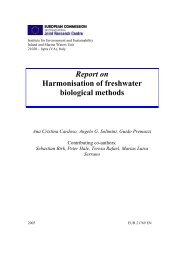Lakes and Watercourses
Lakes and Watercourses
Lakes and Watercourses
You also want an ePaper? Increase the reach of your titles
YUMPU automatically turns print PDFs into web optimized ePapers that Google loves.
Fish<br />
Introduction<br />
Fish form an essential part of freshwater ecosystems <strong>and</strong> it is therefore<br />
important to assess the status of fish communities <strong>and</strong> any changes in<br />
them. A considerable amount is known about the life cycles <strong>and</strong> habitat<br />
requirements of individual species, which means that the structure <strong>and</strong><br />
function of fish communities is also a useful tool for assessing whether<br />
any changes have occurred in the habitat.<br />
The assessments in this chapter are based on a large number of<br />
biologically relevant parameters, weighed together to form an overall<br />
index. All parameters indicate various kinds of change in the biota.<br />
Hence, the overall index gives a mean indication of the status of the fish<br />
community, whereas the individual parameters combine to form a profile<br />
indicating the factors of particular importance to the status of the<br />
community.<br />
The system is to some extent founded on a tried <strong>and</strong> tested US system,<br />
used to assess deviation from original status with the help of fish (Index<br />
of Biotic Integrity – IBI). The original IBI <strong>and</strong> most subsequent applications<br />
have classified impact in relation to unaffected references, which<br />
requires good knowledge of the pristine fish fauna in each instance. An<br />
approach of this kind is scarcely possible in Sweden. Although waters<br />
directly affected by acidification, liming <strong>and</strong> point sources, for example,<br />
can indeed be identified, it is not usually possible to distinguish waters<br />
affected in other ways, eg, by changes in l<strong>and</strong> use, introduction of nonnative<br />
species etc. The reference values presented here therefore constitute<br />
”typical” values for each parameter in relation to the two national<br />
fish databases used, rather than values for ”pristine state”. The analyses<br />
performed show that this approach is still well able to distinguish waters<br />
displaying documented impact from evidently pristine waters.<br />
Historical migrations of fish <strong>and</strong> interaction between species determine<br />
their presence in lakes <strong>and</strong> watercourses. Regional adjustments<br />
have therefore been made by describing parameters on the basis of local<br />
conditions such as height above sea level <strong>and</strong> lake size. This approach<br />
71















![Accommodation booking form [PDF]](https://img.yumpu.com/39471785/1/184x260/accommodation-booking-form-pdf.jpg?quality=85)

